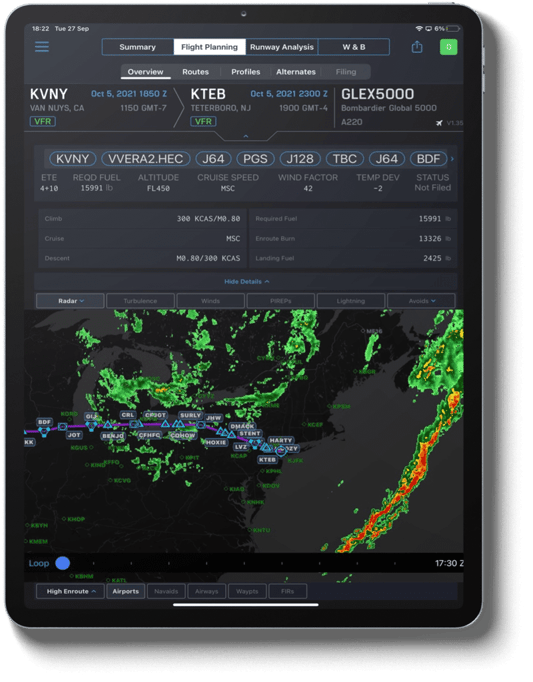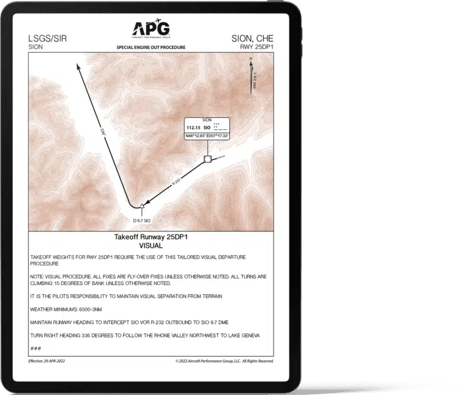
Flight planning is the process of producing a proposed flight path for a specific aircraft, which involves various elements to ensure safe passage from a departure airport to a destination airport. The skies can be congested with thousands of flights at once, so measuring the aircraft’s performance and maintaining compliance with Air Traffic Control (ATC) helps to prevent the risk of mid-air collision and confirms the ability of that aircraft to take off or land at a particular airport.
Electronic Flight Bag Tools
These days, flight planning tools and aircraft performance data can be easily compiled inside an Electronic Flight Bag (EFB) application. Mostly replacing the manual paper calculations of the past, an EFB can quickly and automatically calculate a wide range of data using aircraft specifications, current weather conditions, air restrictions, runway data, atmospheric pressure, wind speed, and weight of the aircraft.
What’s Included in a Flight Plan?
Generally, flight plans follow a common set of requirements to get airborne safely. There are differences in the types of rules based on how the pilot and plane will be flying. Pilots can fly and file according to Visual Flight Rules (VFR), Instrument Flight Rules (IFR), Composite Flight Plan (VFR + IFR), Defense VFR Flight Plan (DVFR), or International Flight Plan (IFP) depending on the purpose of the flight, type of aircraft, and destination.
Here are some of the elements of a flight plan:
Departure and Arrival Airports
The first step in flight planning is to identify the departure and arrival airports. This will determine the route of flight and the amount of fuel required. In addition to an arrival airport, an alternate airport is identified in case the destination airport is closed due to weather or other reasons. The alternate airport should be located within a safe distance of the destination airport. Runway analysis calculations will determine the acceptable facilities to allow the aircraft to land safely.
Flight Path
A flight path represents an aircraft’s airborne movement from the initial position, through a series of intermediate points, to its ultimate destination.
A flight path can be described by several variables, including the initial and final position, altitude, ground speed, true heading, vertical speed, and time required to fly the route. A planned route can change in-flight depending on adjustments the pilot makes to the aircraft's heading, speed, and altitude to avoid weather hazards or other obstacles.
There are slight variations in planning a flight for VFR (Visual Flight Rules). Visual flying requires the pilot to select a route that fulfills the VFR requirements, like airspace restrictions, geographic landmarks, and visual navigation aids like windsocks and painted runway markings. VFR flight paths still consider the aircraft’s capabilities, the aircraft's payload at different segments, distance to travel, altitude, the pilot’s experience, and the rules set by ICAO (International Civil Aviation Organization) for safe planning..png?width=552&height=552&name=NG-%20APG%20%26%20NaviGuard%20iPads%20(1).png)
Altitude
The altitude of the flight will affect the fuel burn and the amount of time it takes to reach the destination. It is important to choose an altitude that is appropriate for the aircraft’s performance and the weather conditions.
Fuel Efficiency & Planning
Flight planning is as much about fuel efficiency as it is about safety. Operations that burn large amounts of jet fuel throughout their fleet can quickly realize the benefit of fuel burn optimization because of proper planning.
The amount of fuel required will depend on the distance of the flight, the aircraft’s fuel burn rate given the payload, and expected weather conditions. It is important to carry enough fuel to reach the destination safely (with a significant margin) and to divert to an alternate airport if necessary.
Jet streams, or air currents between the layers in the Earth’s atmosphere, specifically the troposphere and the stratosphere, are one of the most significant factors affecting fuel consumption during a flight.
A well-known example of how jet streams can affect fuel consumption is the transatlantic sector between North America and Europe. Strong winds traveling West to East from North America to Europe can have a major impact on flight planning. An example would be to imagine cycling into a 10 knot headwind (Europe to North America) vs having that same 10 knot tailwind (North America to Europe). The amount of energy you’ll save traveling with a tailwind will be significant.
Weather
The weather conditions along the route of flight and at the destination airport must be checked before the flight. For flights over longer distances, weather can often be different than the current departure airport. Checking and understanding the weather helps to identify any potential hazards and to plan for the possibility of delays or cancellations.
Pilots use a variety of methods to confirm local weather. They are looking at visibility, cloud cover, wind speeds, barometric pressure, and current or developing hazards. Inflight reports can be sourced from METARs (current conditions), TAFs (forecasts), radar, measured or forecasted winds, SIGMETs, AIRMETs, and many other types of weather information.

Weight & Balance
The weight and location of passengers and payload added to an aircraft an important factors for safe air travel. An aircraft has specific limitations on how much it can safely carry and the fuel it uses to carry that weight. Calculations include passengers, baggage, overall weight, center of gravity, and the amount of fuel on board. This calculation can change based on lighter or heavier than expected cargo, a change in the number of passengers, and, of course, a change in destination. Depending on available seats and the configuration of an aircraft, the added weight must be distributed so that the flight performance characteristics of the aircraft are not impacted beyond safe margins.

Communication
Flight planning can be as simple as a single pilot flying solo or a full crew with multiple members. Larger operations will need to communicate between pilots, dispatchers, co-pilots, flight crews, passengers, Air Traffic Control (ATC), etc. This may include filing a flight plan, obtaining clearance, and communicating with controllers during the flight.
Electronic Flight Bag software makes this easy by compiling all the necessary flight planning and aircraft performance data and sending it via email or uploading it to a cloud-based platform for others to view.
Emergency procedures
The pilot should be familiar with the emergency procedures for the aircraft. This includes procedures for engine failure, also called Engine Out Procedures (EOP), in-flight emergencies, and ditching. Each airport will have a specific procedure, altitude, and path that an aircraft must follow for safety.

How to File a Flight Plan
The purpose of filing a flight plan is to record your path of travel. Filing indicates to the FAA (Federal Aviation Administration) that you have chosen a path, reviewed weather data, and checked NOTAMs and flight restrictions. Before filing a flight plan, you will need information on the type of aircraft you are flying, the aircraft’s true airspeed, and its tail number.
Filing a flight plan is often standardized by the FAA to keep things organized. Pilots often use the International Civil Aviation Organization (ICAO) formatting to ensure consistency. Domestic flights that don’t meet the ICAO criteria are still allowed by the FAA to file their domestic flight plan, however, that is planned to be phased out soon.
Flight plans can be filed in any of the following ways:
Flight Planning Apps
There are several advanced flight planning apps available to plan and file in just a few minutes. A wide range of aircraft information is pre-loaded so that flight planning and aircraft performance calculations can be done in seconds. These apps also make it easy to communicate and share with crews, dispatchers, and air traffic controllers. Another significant benefit of a mobile flight planning application is the availability of several tools combined into one place. Chart data, runway analysis, weight and balance, engine out procedures, and geo-referenced plates are other features available in apps like iPreFlight Genesis PRO.
See how you can file a flight plan in under three minutes
Filing a Flight Plan by Phone
Even with automated flight planning applications, there is still a “manual” way to file a flight plan. Filing by phone can be done through 1-800-WX-BRIEF (1-800-922-7433). You simply announce the state you are departing from and tell the briefer the information contained on your printed flight plan document. The representative will verify the information about your flight plan by reading it back to you. Once the flight plan information is verified, they will confirm it has been filed.
Online Flight Plan Filing
Similarly, to the phone method, filing online can be done through 1800wxbrief.com. This site is offered through the FAA to file an ICAO flight plan or a domestic flight plan. Once logged in, you can save flight plans to quickly recall them if there are common routes and aircraft flown. This can make it simpler to get airborne quicker and safely.


